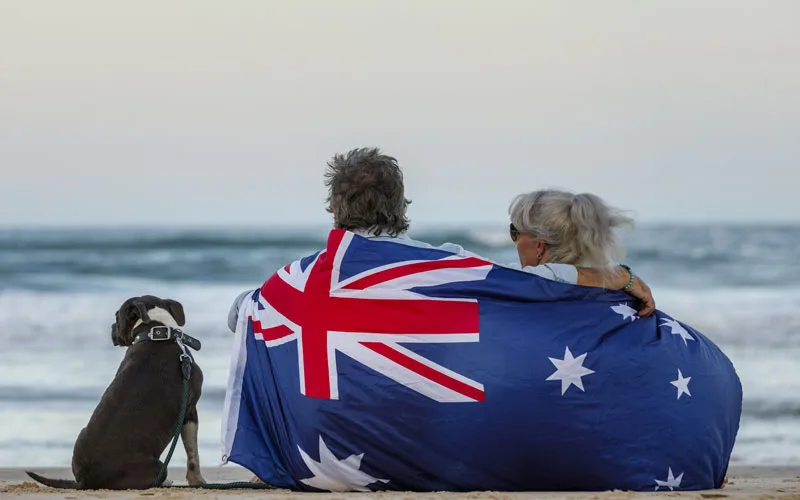On This Page...
ToggleIntroduction: Why This Guide Exists
After decades of helping thousands of couples apply for partner visas — across every relationship type, background, and visa complication — I’ve learned one hard truth: most people don’t fully understand what they’re walking into. And that’s not their fault. The process is complex, the stakes are high, and the rules aren’t always clear. But getting it wrong can cost more than just time and money. It can cost your future together.
This guide is for couples who are trying to stay together in Australia through the de facto partner visa process. Whether you’re same-sex or opposite-sex, married or unmarried, living together or long distance — this is your roadmap. It’s written in plain English and built on more than 25 years of experience advising on real cases, in real-life situations.
We’ll cover the key questions you probably already have — and more importantly, I’ll answer the ones you didn’t even know to ask.
I want this to be the most accurate, up-to-date, and useful guide available. So if you come across anything in this article that needs clarification or updating, please reach out. It won’t just help me — it will help our whole community of applicants, lawyers, agents and partners working toward better immigration outcomes.
Because when we get the information right, we give people their future back.
Section 1: Understanding the Partner Visa Framework
The Australian partner visa program is designed to keep couples together where one person is an Australian citizen, permanent resident, or eligible New Zealand citizen, and the other is not.
There are two main processing pathways:
A. Onshore Partner Visa – Subclass 820/801
This is for couples who are both in Australia.
- You apply while you’re in Australia
- You usually get a Bridging Visa while your application is processed
- After two years, you may be eligible for permanent residency via subclass 801
B. Offshore Partner Visa – Subclass 309/100
This is for couples applying from outside Australia.
- The applicant must be outside Australia at the time of application
- They receive subclass 309 (temporary) first
- After two years, you may be eligible for permanent residency via subclass 100 (permanent)
Both streams involve a two-stage process, and both require a significant amount of evidence, time, and patience.
Section 2: What “De Facto” Really Means in Australian Migration Law
The word “de facto” gets thrown around a lot, but in immigration law, it has a specific meaning — and simply living together isn’t enough.
You’re in a de facto relationship if:
- You are not married to each other
- You are not related by family
- You live together (or have lived together) on a genuine domestic basis
- You are in a mutual commitment to a shared life, to the exclusion of all others
Many couples assume sharing a house equals de facto. Not necessarily. If you’re just flatmates, or there’s no financial or emotional interdependence, you won’t qualify.
On the other hand, some couples who don’t live together full-time — due to FIFO work, military service, or other reasons — may still meet the definition if they can show a shared life in other ways.
The relationship must also be genuine and continuing at the time of application. This is critical. If you’re separated at the time of lodgement, or if the relationship isn’t real (on paper or in life), your application is likely to fail — and no amount of appeal strategy can undo that.
Section 3: The 12-Month Rule and Relationship Registration Workaround
To apply as a de facto partner, you usually need to show that:
- You’ve lived together for at least 12 months, and
- That cohabitation occurred immediately before lodging your application.
But there’s a workaround — and it’s a very strategic one.
If you register your relationship with an Australian state or territory that has a formal relationship register, you can skip the 12-month cohabitation requirement.
This is especially useful for:
- Long-distance couples
- Couples who’ve only recently moved in together
- Couples whose living situation makes cohabitation impractical
Section 4: Where Can You Register Your Relationship?
Here’s how the states and territories stack up:
✅ Relationship Registration Available:
- New South Wales
- Victoria
- Queensland
- South Australia
- Tasmania
- Australian Capital Territory
These states allow both same-sex and opposite-sex couples to register a relationship, even if they haven’t lived together for a full 12 months.
Registration usually takes 28 days (after a cooling-off period) and requires proof of identity and residence in that state.
❌ Registration Not Available:
- Western Australia
- Northern Territory
If you live in WA or NT and don’t have 12 months of cohabitation, you may be forced to wait — or move interstate temporarily.
Section 5: Same-Sex Couples and the Impact of Marriage
Since December 2017, same-sex marriage has been legal in Australia. That means same-sex couples who are married enjoy the same rights as opposite-sex couples when applying for a partner visa.
If you are married, you do not need to prove 12 months of cohabitation. The marriage itself satisfies the relationship requirement — but only if it’s recognised under Australian law.
If you were married overseas, and the country where you married also recognises same-sex marriage, then your marriage is likely to be recognised here.
However, you still need to prove that your relationship is genuine and continuing — marriage is not a shortcut. The Department will still assess the financial, social, household, and commitment aspects of your relationship.
Section 6: Can You Apply Onshore?
Yes — but only if your current visa doesn’t have restrictions.
The onshore partner visa (820/801) is available only if:
- You are physically in Australia
- You hold a visa that allows you to make a further application
- Your visa does not have Condition 8503 – No Further Stay
Many visitors arrive on a subclass 600 tourist visa. Some of those visas come with 8503, which prevents you from lodging another substantive visa while in Australia.
If that’s you, your options are limited:
- You can apply for a waiver of 8503 — but it’s not guaranteed
- Or you’ll have to leave Australia and apply from offshore (309/100)
Section 7: What Happens After Lodging Onshore?
Once you lodge a valid onshore application:
- You’ll receive a Bridging Visa A (BVA)
- That visa activates when your current visa expires
- You’ll be able to stay lawfully in Australia
- You’ll usually be granted full work rights
- You’ll be eligible for Medicare
A key point: work rights only start when the bridging visa becomes active — not while you’re still on a visitor visa. If your visitor visa lasts three months, you may have to wait that long before you can work.
If you need to travel overseas while waiting for your application to be processed, you must apply for a Bridging Visa B (BVB) before leaving — or you risk not being able to return.
Section 8: What the Department Wants to See — And What They Don’t
The Department of Home Affairs doesn’t care about how much you love each other. It cares about how well you can prove you live like a couple.
Your application will be assessed across four broad categories:
1. Financial Aspects
You need to show financial interdependence. This might include:
- A joint bank account that you both actually use
- Shared rent or mortgage payments
- Joint bills
- Car loans, insurance, or other liabilities in both names
A “sleeping” joint account with no real activity won’t help. They want to see real financial blending.
2. Household Aspects
The question here is: are you living together as a couple or just sharing a space?
- Mail going to the same address
- Joint household responsibilities (cleaning, cooking, planning)
- Lease agreements, tenancy contracts
Declarations from others (via Form 888) are useful, but your own statements — well-written and detailed — often make or break the application.
3. Social Aspects
Do your friends and family know you’re together?
- Photos at social events
- Wedding invites (as a couple)
- Holidays or trips
- Statements from people close to you
Be careful with social media — too much can look performative, too little can raise eyebrows. Be real.
4. Nature of the Commitment
This is the most subjective part, but the most powerful when done well.
- Your plans for the future
- How you support each other emotionally and practically
- Whether you’re listed as beneficiaries on insurance or wills
Section 9: My Embedded Evidence Checklist
Here’s what I recommend you gather:
– Joint bank statements with active use
– Shared lease or mortgage documents
– Utility bills and shared service contracts
– Screenshots of meaningful messages or call logs (especially early in the relationship)
– Social media screenshots (if relevant, not spammed)
– Photos — mix of everyday life and special events
– Travel history — flight tickets, hotel bookings, itineraries
– Statutory declarations from both partners
– At least two Form 888s from friends or family
– A relationship certificate (if registered)
– Future plans — housing, children, financial goals
Don’t overwhelm the case officer. Choose quality over quantity. Curate your evidence like a story — beginning, middle, and continuing.
Section 10: What If You Separate?
If your relationship ends before your partner visa is granted — whether temporary or permanent — your application is likely to be refused.
If you’ve already been granted a temporary partner visa, you may still be eligible for a permanent visa in certain situations:
- You and your partner have children together
- You’ve experienced family violence during the relationship
These are serious cases that require detailed legal support. You must act quickly and carefully.
Section 11: What If Your Application Is Refused?
You will usually have access to merits review through the Administrative Review Tribunal (ART).
Key facts:
- The ART fee is currently around $3,496
- You must lodge the appeal within a strict deadline
- A successful appeal will set aside the refusal and send it back to the Department
But — and this is critical — no appeal will fix a defective application lodged with the wrong relationship status.
This brings me to one of the most important principles in Australian migration law:
Section 12: The Time Machine Rule (And Why It Matters)
If you’re not in a genuine relationship at the time of application, no amount of time that passes later can save you.
Let me say that again: you can’t backdate a relationship.
You cannot become a de facto couple after applying and hope to patch it up during review. The Tribunal will assess whether you met the legal requirements on the day you lodged the visa. If you didn’t — the case is over.
I call this the Time Machine Rule, because I’ve seen so many people wish they could go back and “fix” the facts. But there is no Time Machine. The law is locked to the moment of application.
Even the best immigration lawyer in the world can’t overcome a fatal defect like that.
Section 13: Prospective Marriage Visa vs Partner Visa
Let’s clear this up.
The Prospective Marriage Visa (subclass 300) is for people who are:
- Engaged to be married
- Not yet living in a de facto relationship
- Intend to marry within 9 months of arriving in Australia
This visa is not a workaround for people who don’t qualify for a partner visa.
If the Department assesses that you’re already living together as a de facto couple, they’ll expect you to apply under the 309/100 or 820/801 pathways. Applying for a PMV in that case can backfire.
I’ve seen couples tripped up by this — thinking they can delay the heavy evidence by applying for a PMV, when really, they’re already de facto in the eyes of immigration law.
Section 14: Application Fees and Strategic Costs
The Department of Home Affairs charges $9,095 to lodge most partner visa applications. This is payable in full at the time of application.
That fee doesn’t include:
- Medical examinations
- National Police Checks
- Certified translations
- Legal advice
- Additional child dependants
It’s one of the most expensive visas in the system — which is why strategy matters so much. A poorly prepared application costs just as much as a perfect one… until it gets refused.
Section 15: Permanent Residency and the 5-Year Travel Trap
Getting your permanent partner visa — subclass 801 or 100 — is a major milestone. But don’t let the word “permanent” fool you.
Your permanent visa comes with a five-year travel facility.
That means you can leave and return to Australia freely for five years from the date your PR is granted. But after that five years?
You must apply for a Resident Return Visa (RRV) to travel again.
If you’re overseas when your travel rights expire, you won’t be able to return unless your RRV is granted while you’re still overseas. This has stranded many permanent residents who assumed they could come and go as they pleased.
Plan for this:
- Track your permanent visa grant date
- Set a reminder before five years is up
- If you haven’t applied for citizenship, apply for an RRV before travelling
Section 16: Final Thoughts — Why People Trust Me
This process is personal. It’s not just about law or documents — it’s about lives, families, futures.
I’ve been helping couples with partner visas since the 1990s. I’ve seen every version of this system, and I know what works and what doesn’t.
What makes my process different? I tell you the truth. I flag the risks. I help you structure your evidence. And I care deeply about your outcome — because I’ve walked beside people just like you through every step of this journey.
Section 17: Ready to Apply?
If you’ve made it this far, you’re serious — and I’d love to help.
You can:
- Book a consult with me online
- Or call the office and say you’ve read the “Definitive Partner Visa Guide”
I’ll review your case. I’ll build your strongest possible application. And I’ll do it properly — because your relationship deserves nothing less.






523 Responses
Hi, Myself & my partner are in the process of applying for De facto relationship after being together for 18 months in Australia. I have been a Perm Resident for 4 years and came here on a subclass 300 Marriage Visa. This Marriage broke down 2 years ago and i have been divorced for 12 months. Can i sponsor my new partner even though i have had my Perm Residency for 4 years and there is a 5 year rule?
Hi there,
A few questions here – but hopefully they are relevant for all! My partner (Romanian citizen) and I (Australian citizen) are planning to put in an off shore de facto visa application in a few months, but in the meantime we are also looking into Independent Skilled Visa option because the waiting time is significantly lower. My questions are:
– If our application for the Independent Skilled Visa is declined due to eligibility (such as due to the profession not being needed), will this affect our De Facto visa application? My partner has a completely clean record and positive character reference so that wouldn’t be a problem.
– Is it possible to apply for the de facto visa while we are awaiting the outcome of the Independent Skilled Visa?
And, separately:
– We want to spend Christmas in Australia together, but we are not sure whether it’s better to apply for the eVisitor visa before or after we lodge our de facto and/or his skilled visa application. We are worried due to his relationship with me and our clear intentions to re-locate, my partner won’t be able to demonstrate close enough ties to his country so might be refused. If an eVisitor visa is refused, would that affect the outcome of our longer-term visa applications?
Thanks in advance for your help!
Hi,
Good day Sir Nilesh!
My partner was already in Australia holding visa subclass 482 and right now we are thinking if i’m illegible to apply for subsequent visa 482 because we are already in Defacto relation since 2017 when we are both here in our home country. We have already gathered some documents like travel tickets, hotels receipt, photos together, affidavit from our parents and close friends, and my partner in Australia also submitted an application to register our relation under Relationship Register Act 2010 (NSW) and right now we are waiting for the result. But the problem is when we check her visa subclass 482, her marital status is not in De Facto, and it is in single status. Her visa agent change the status during the submission of the visa application. Now my question is if do I still have a chance to be granted if I apply for subsequent visa subclass 482? If not what we can do with this miss match information in the visa of my partner?
Thank you for the great post. Are the same rules apply to de facto partner on 189 visa? We are in a genuine relationship since July 2017 and we live together since September 2017.
We have following documents to prove our relationship:
– Tenant addition addendum to my tenancy contract – signed by the landlord on 30/09/2017 – confirms we live together and we are both responsible for the property.
– A high number of pictures and posts on social media from several different countries where we were on holidays – since 30/07/2017.
– 12 airline boarding passes for trips since 30/09/2019.
– Car Insurance with our both names on – since 03/09/2017.
– Some invitations for weddings and parties with our names on.
– 2017 and 2018 Christmas cards from our friends with both names on.
– Some letters confirm we both live in the same address
– Our driving licences show the same home address.
– Her speeding police ticket with our car 😉
– We have lots of mutual friends on social media
– We can have as many we want statements from our friends and family.
– Some bank transfer between our accounts to prove that we share financial responsibilities.
Do you think that would be enough? We were considering to get married before we lodge the vise (most likely in March), but this would look really fake to get married just before visa application.
I am still legally married in Australia , applied for tourist and sponsored visa for my defacto partner whom I have a daughter(Australian Citizen by descent) overseas. It was twice rejected? I understand you cant bring second partner until you are divorced with first one but for family visit is ok?
Hi, I’m an Australian Permanent Resident, My wife and I have been in a genuine relationship for more than 8 years and have been married for a year. My wife applied for an offshore partner visa, we provided all evidence of our long term relationship and she was granted the provisional visa recently. My query is to why she was not granted the permanent partner visa as we had provided ample evidence of our long term relationship? What should we do to reduce the two-year waiting period to be granted the permanent partner visa?
Hello,
I want to apply for the partner visa and my girlfriend wants so sponsor me. She got her own 801 partner visa granted in 2016. I found out that she is allowed to be a sponsor if her partner visa was applied more than 5 years ago, that was 2012. While filling out the online application i received a warning “Partner visas sponsors may be subject to sponsorship limitations if they were granted a partner visa in the past 5 years”. Which date counts for the sponsor limitation? The date af application or the date it was granted?
Kind regards
Hermann